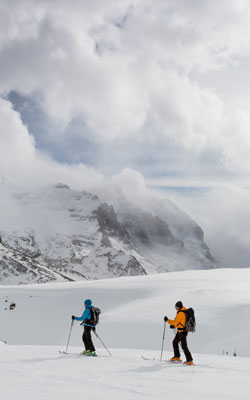
Ski touring, alpine ski touring, and ski mountaineering
Jasper National Park
Jasper National Park offers a wide range of easy short ski touring, alpine ski touring and ski mountaineering day trips to long multi-day glacial traverses. These areas are often in wild and uncontrolled avalanche and glacier terrain. The cold dry snowpack, famous for its spectacular light powder, is typically weak and unstable during the early winter (December, January) and backcountry ski travel is often difficult at this time. Cross-country skiing, downhill skiing at the lift-serviced ski area and ski touring in the valley bottoms are all that can be recommended during this part of the season. The snowpack can normally be depended upon to provide a solid enough base to carry off-piste and backcountry skiers by mid-February, but this is also when the larger avalanches of the season occur so careful route-finding is imperative on mountain trails and routes. The alpine touring season improves from February onward and is recommended through April and May on the Icefields and peaks along the Continental Divide.
Venturing into the backcountry of Jasper National Park requires a basic level of avalanche knowledge and self-reliance. The weather can change rapidly in the mountains, and temperatures may drop to as low as -40 degrees Celsius, even in March. Avalanches are a common occurrence. Do not venture onto glaciated terrain unless everyone in your group is properly equipped and familiar with safe glacier travel, crevasse rescue techniques, and whiteout navigation skills. Considerable level of skill and knowledge is required to navigate through ATES type 2 and 3 avalanche terrain (Avalanche Terrain Exposure Scale). Avalanche educational courses are offered through the Avalanche Canada.
Avalanches
No avalanche control takes place in the backcountry other than for the purposes of highway corridor avalanche control. Daily backcountry Avalanche Bulletins are prepared by professional avalanche forecasters in the Visitor Safety Program between December and April. The Jasper avalanche forecast covers the area from the Maligne Valley south to Saskatchewan River Crossing in Banff National Park. These forecasts can be viewed online and can be found posted in the Jasper Information Centre and at local retailers.
The avalanche danger can change rapidly with changing weather. Be observant of changing conditions and early warning signs during your ski trip. Be willing to turn around if conditions are not safe. Before heading out be sure to check the mountain weather forecast online with Avalanche Canada.
Avalanche control
The Icefields Parkway and the road to Maligne Lake travel through many avalanche paths, which are posted with signs marking their start and end points. Do not stop or park between these signs as you are at danger from avalanches here.
Avalanche control activities take place along these sections of highways, and the road may be closed during these times for several days at a time. Road updates are available through Alberta 511 or through real-time updates and anticipatory closures on twitter @ParksMntSafety. Un-detonated explosives may be encountered in these areas.
Do not move or touch any objects that you suspect are explosives and report them immediately to Jasper Dispatch by calling 780-852-6155.
Emergencies
Assume cell coverage is unreliable anywhere in the backcountry and plan alternative means of outside emergency communication (either a personal locator beacon, satellite phone or emergency satellite communication device). Some local rentals are available in Jasper.If you are calling for assistance using a cell, call 911. If using a satellite phone call +1-780-852-3100 for Jasper emergency dispatch. Preprogram this into your device.
Trip preparation

- Pick an objective that is within your ability and have an alternate plan in case conditions changes. For popular trips, check the Avalanche Terrain Exposure Scale.
- Research the trail or trip. Guidebooks can be purchased at local retail stores in the area.
- Check the backcountry Avalanche Bulletin on line.
- Check the weather forecast online.
- Let someone at home know your plans for the day and when you are expected back.
- Go with a friend.
- Take your avalanche safety gear and know how to use it if you are venturing into avalanche terrain.
- Be prepared to be self-sufficient if you encounter bad weather or have an accident by packing the right clothing and emergency equipment.
- As you drive to the trailhead observe the landscape and what the weather is doing. Ask yourself is the avalanche danger changing. Look for signs of recent avalanche activity and be prepared to change your objectives for the day.
- Check the information boards at the trailheads.
Season length
Snow cover varies greatly with elevation. On the ice caps in the park, skiing is possible year round. At lower elevations in the valley bottoms skiing is between early December and April.
Seasonal closures for caribou conservation
From November to the middle of May, access to occupied caribou ranges is closed to prevent people from creating packed trails that could give wolves access to important winter caribou habitat. In Jasper National Park, critical caribou habitat is protected by law under Canada’s Species at Risk Act. To learn more and view detailed maps of the closures please visit parkscanada.gc.ca/caribou-winter-access.
Alpine ski and ski-mountaineer trips
Parkers Ridge, Destiny Ridge and Tangle Creek (ATES Class 2)
Churchill Slide Paths (ATES Class 2)
Nigel Pass and Nigel Basin (ATES Class 2)
Kitchener Indicator Slopes (ATES Class 2)
PR Slopes (ATES Class 2)
Columbia Icefield (ATES Class 3)
Diadem Creek (ATES Class 3)
Surprise Creek (ATES Class 2)
Bald Hills and Shangri-la (ATES Class 1)
Bringing a youth group into Jasper National Park?
Review the policies for custodial groups planning backcountry travel in the mountain National Parks (Banff, Yoho, Kootenay, Jasper, Mt. Revelstoke, Glacier, and Waterton Lakes).
Stay connected
For current conditions and avalanche bulletins
Follow Parks Mountain Safety on Facebook and Twitter @ParksMntSafety
Follow the link to http://www.parksmountainsafety.ca/
- Date modified :